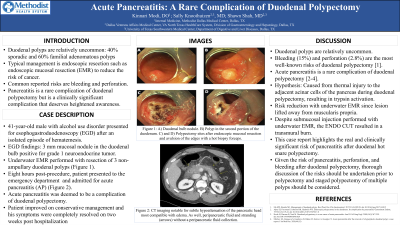Sunday Poster Session
Category: Interventional Endoscopy
P0885 - Acute Pancreatitis: A Rare Complication of Duodenal Polypectomy
Sunday, October 22, 2023
3:30 PM - 7:00 PM PT
Location: Exhibit Hall

Has Audio

Kinnari Modi, DO
Methodist Dallas Medical Center
Dallas, TX
Presenting Author(s)
Kinnari Modi, DO1, Sally Knooihuizen, MD2, Shawn Shah, MD3
1Methodist Dallas Medical Center, Dallas, TX; 2UT Southwestern Medical Center, Lincoln, NE; 3Dallas VA Medical Center / University of Texas Southwestern Medical Center, Dallas, TX
Introduction: Duodenal polyps are uncommon with nearly 40% sporadic and 60% in patients with familial adenomatous polyposis. These polyps are typically managed by endoscopic resection to reduce the risk of cancer. Often, endoscopic mucosal resection (EMR) is performed to remove polyps, which may involve a submucosal injectate lift to minimize the risk of perforation. Common reported risks associated with this technique is bleeding and perforation. Pancreatitis is a rare complication of duodenal polypectomy.
Case Description/Methods: A 41-year-old male presented for esophogastroduodenoscopy (EGD) after an isolated episode of hematemesis. Initial EGD was notable for a 3 mm mucosal nodule in the duodenal bulb, which was biopsied and found to be a grade 1 neuroendocrine tumor. He underwent a repeat EGD for underwater EMR with resection of 3 non-ampullary duodenal polyps. Eight hours post-procedure, he returned to the emergency department with acute pancreatitis due to a complication of duodenal polypectomy. He improved significantly after conservative treatment. The patient was seen in clinic two weeks after discharge with no residual symptoms.
Discussion: Duodenal polyps are uncommon, and pancreatitis is a rare complication of non-ampullary polypectomy noted in only a few case reports to date1-3 but is a clinically significant complication that deserves heightened awareness. Pancreatitis is thought to result from thermal injury to the adjacent pancreas given the proximity of the pancreatic head to the duodenal bulb4. Transmitted thermal energy may result in injury or destruction to the adjacent acinar cells, resulting in activation of trypsin2. This risk is decreased in underwater EMR since the lesion is lifted away from the muscularis propria, decreasing transmission of thermal injury. In our case, despite underwater EMR with submucosal injectate, a transmural burn occurred with resultant pancreatitis. Hence, all patients should be monitored closely post-procedure and given explicit return instructions if symptoms of pancreatitis were to develop.
References:
1. Alper EI, et al. Endoscopic polypectomy in the duodenum. Its complication by pancreatitis. 1975, 119-122
2. Kwak H, Darmas B, Nutt M. Duodenal polypectomy is a rare cause of acute pancreatitis. 2009, W7-W9.
3. Mirchev M, et al. Acute pancreatitis after the removal of a hyperplastic duodenal polyp: a case report. 2020, 48.
4. Ma MX, Bourke MJ. Management of duodenal polyps. 2017, 389-399.
Disclosures:
Kinnari Modi, DO1, Sally Knooihuizen, MD2, Shawn Shah, MD3. P0885 - Acute Pancreatitis: A Rare Complication of Duodenal Polypectomy, ACG 2023 Annual Scientific Meeting Abstracts. Vancouver, BC, Canada: American College of Gastroenterology.
1Methodist Dallas Medical Center, Dallas, TX; 2UT Southwestern Medical Center, Lincoln, NE; 3Dallas VA Medical Center / University of Texas Southwestern Medical Center, Dallas, TX
Introduction: Duodenal polyps are uncommon with nearly 40% sporadic and 60% in patients with familial adenomatous polyposis. These polyps are typically managed by endoscopic resection to reduce the risk of cancer. Often, endoscopic mucosal resection (EMR) is performed to remove polyps, which may involve a submucosal injectate lift to minimize the risk of perforation. Common reported risks associated with this technique is bleeding and perforation. Pancreatitis is a rare complication of duodenal polypectomy.
Case Description/Methods: A 41-year-old male presented for esophogastroduodenoscopy (EGD) after an isolated episode of hematemesis. Initial EGD was notable for a 3 mm mucosal nodule in the duodenal bulb, which was biopsied and found to be a grade 1 neuroendocrine tumor. He underwent a repeat EGD for underwater EMR with resection of 3 non-ampullary duodenal polyps. Eight hours post-procedure, he returned to the emergency department with acute pancreatitis due to a complication of duodenal polypectomy. He improved significantly after conservative treatment. The patient was seen in clinic two weeks after discharge with no residual symptoms.
Discussion: Duodenal polyps are uncommon, and pancreatitis is a rare complication of non-ampullary polypectomy noted in only a few case reports to date1-3 but is a clinically significant complication that deserves heightened awareness. Pancreatitis is thought to result from thermal injury to the adjacent pancreas given the proximity of the pancreatic head to the duodenal bulb4. Transmitted thermal energy may result in injury or destruction to the adjacent acinar cells, resulting in activation of trypsin2. This risk is decreased in underwater EMR since the lesion is lifted away from the muscularis propria, decreasing transmission of thermal injury. In our case, despite underwater EMR with submucosal injectate, a transmural burn occurred with resultant pancreatitis. Hence, all patients should be monitored closely post-procedure and given explicit return instructions if symptoms of pancreatitis were to develop.
References:
1. Alper EI, et al. Endoscopic polypectomy in the duodenum. Its complication by pancreatitis. 1975, 119-122
2. Kwak H, Darmas B, Nutt M. Duodenal polypectomy is a rare cause of acute pancreatitis. 2009, W7-W9.
3. Mirchev M, et al. Acute pancreatitis after the removal of a hyperplastic duodenal polyp: a case report. 2020, 48.
4. Ma MX, Bourke MJ. Management of duodenal polyps. 2017, 389-399.
Disclosures:
Kinnari Modi indicated no relevant financial relationships.
Sally Knooihuizen indicated no relevant financial relationships.
Shawn Shah indicated no relevant financial relationships.
Kinnari Modi, DO1, Sally Knooihuizen, MD2, Shawn Shah, MD3. P0885 - Acute Pancreatitis: A Rare Complication of Duodenal Polypectomy, ACG 2023 Annual Scientific Meeting Abstracts. Vancouver, BC, Canada: American College of Gastroenterology.
